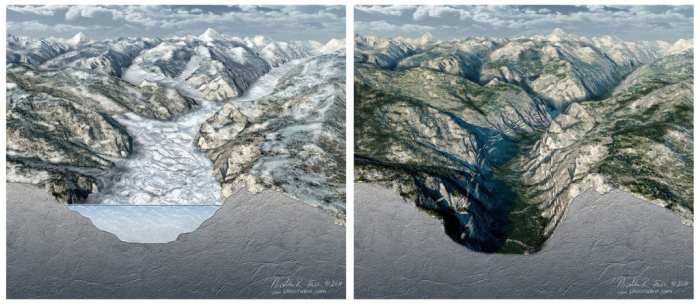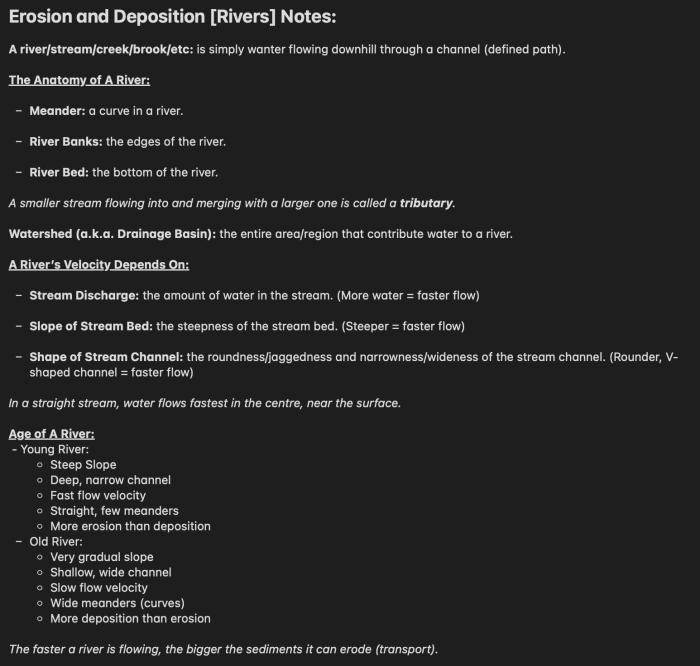Which of the following features characterize wide streams and valleys? This question delves into the realm of fluvial geomorphology, exploring the distinctive characteristics that distinguish these expansive aquatic and terrestrial landscapes. From their morphological attributes to their ecological significance, wide streams and valleys present a captivating subject of study, inviting us to unravel their unique features and processes.
Wide streams and valleys are characterized by their considerable width, typically exceeding several hundred meters. Their channels exhibit a meandering or braided pattern, with gentle gradients and low sinuosity. The valleys they occupy are broad and open, often with well-developed floodplains and terraces.
Morphological Characteristics of Wide Streams and Valleys

Wide streams and valleys are distinguished by their exceptional width compared to their depth and sinuosity. They exhibit unique morphological features that set them apart from narrower counterparts.
Typical width ranges for wide streams and valleys vary depending on the geomorphic context and the scale of observation. However, they generally exceed 100 meters in width and can extend up to several kilometers in some cases. Their dimensions are often disproportionate, with widths significantly greater than their depths.
The shapes and cross-sectional profiles of wide streams and valleys are diverse. They may exhibit straight or meandering channels, with varying degrees of sinuosity. Their cross-sections often display a flat or gently sloping bottom, with steep or terraced banks. The presence of point bars, mid-channel bars, and oxbow lakes is common in meandering wide streams and valleys.
Geomorphic Processes Shaping Wide Streams and Valleys
The formation of wide streams and valleys is attributed to a combination of geomorphic processes operating over extended periods. Fluvial processes, such as erosion, deposition, and lateral migration, play a dominant role in shaping these landscapes.
Erosion by flowing water gradually widens stream channels and valley floors. Lateral migration, the process by which a river’s course shifts across its floodplain, contributes to the development of wide valleys. Deposition of sediment, particularly during flood events, creates point bars and other features that further widen the stream or valley.
Tectonic activity and climate can influence the formation of wide streams and valleys. Tectonic uplift or subsidence can alter the gradient and flow patterns of rivers, leading to the development of wide valleys. Climate, particularly precipitation patterns, can affect the volume and erosive power of rivers, influencing the rate of channel widening.
Hydrological Characteristics of Wide Streams and Valleys

Wide streams and valleys exhibit distinct hydrological characteristics that influence their ecological functions and management.
Flow patterns in wide streams and valleys are often characterized by low velocities and extended residence times. Discharge rates can vary significantly depending on the size of the watershed and the seasonality of precipitation. During high-flow events, wide streams and valleys can accommodate large volumes of water, reducing the risk of flooding in adjacent areas.
Water depths in wide streams and valleys are typically shallow, with depths rarely exceeding a few meters. This shallowness promotes the development of diverse aquatic habitats and supports a wide range of plant and animal species.
Ecological Significance of Wide Streams and Valleys

Wide streams and valleys are ecologically important landscapes that support diverse habitats and ecosystems.
The shallow waters and slow-moving currents provide suitable conditions for the growth of aquatic vegetation, which forms the foundation of food webs. The riparian zones along wide streams and valleys offer essential habitat for terrestrial wildlife, providing food, cover, and nesting sites.
Wide streams and valleys play a crucial role in maintaining biodiversity and ecosystem services. They serve as corridors for wildlife movement, facilitate nutrient cycling, and contribute to the overall health and resilience of riverine ecosystems.
Management and Conservation of Wide Streams and Valleys
The management and conservation of wide streams and valleys are essential for maintaining their ecological integrity and the benefits they provide.
Protecting and restoring riparian zones and wetlands is crucial for preserving the ecological functions of wide streams and valleys. Riparian vegetation helps stabilize banks, filters pollutants, and provides habitat for wildlife. Wetlands within these landscapes act as natural sponges, absorbing floodwaters and improving water quality.
Successful conservation and restoration projects for wide streams and valleys involve collaboration among stakeholders, including landowners, government agencies, and non-profit organizations. These projects aim to restore degraded riparian zones, reconnect fragmented habitats, and reduce pollution inputs to protect and enhance the ecological value of these landscapes.
Quick FAQs: Which Of The Following Features Characterize Wide Streams And Valleys
What is the typical width range of wide streams?
Wide streams typically exceed several hundred meters in width.
What is the relationship between stream width and discharge capacity?
Wider streams generally have a higher discharge capacity, allowing them to convey larger volumes of water during floods.